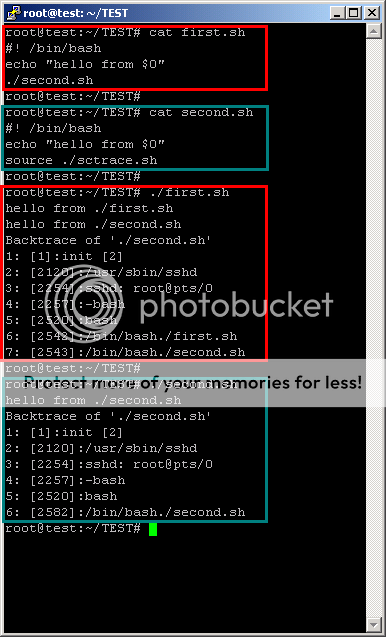跟踪由Bash脚本调用的已执行程序
脚本行为不端。我需要知道是谁调用了那个脚本,谁调用了调用脚本,等等,只能修改行为不端的脚本。
这类似于堆栈跟踪,但我不对单个bash脚本中的函数调用的调用堆栈感兴趣。 相反,我需要由我的脚本启动的已执行程序/脚本链。
8 个答案:
答案 0 :(得分:15)
我几天前写的一个简单的脚本......
# FILE : sctrace.sh
# LICENSE : GPL v2.0 (only)
# PURPOSE : print the recursive callers' list for a script
# (sort of a process backtrace)
# USAGE : [in a script] source sctrace.sh
#
# TESTED ON :
# - Linux, x86 32-bit, Bash 3.2.39(1)-release
# REFERENCES:
# [1]: http://tldp.org/LDP/abs/html/internalvariables.html#PROCCID
# [2]: http://linux.die.net/man/5/proc
# [3]: http://linux.about.com/library/cmd/blcmdl1_tac.htm
#! /bin/bash
TRACE=""
CP=$$ # PID of the script itself [1]
while true # safe because "all starts with init..."
do
CMDLINE=$(cat /proc/$CP/cmdline)
PP=$(grep PPid /proc/$CP/status | awk '{ print $2; }') # [2]
TRACE="$TRACE [$CP]:$CMDLINE\n"
if [ "$CP" == "1" ]; then # we reach 'init' [PID 1] => backtrace end
break
fi
CP=$PP
done
echo "Backtrace of '$0'"
echo -en "$TRACE" | tac | grep -n ":" # using tac to "print in reverse" [3]
......还有一个简单的测试。

我希望你喜欢它。
答案 1 :(得分:7)
~$ help caller
caller: caller [EXPR]
Returns the context of the current subroutine call.
Without EXPR, returns "$line $filename". With EXPR,
returns "$line $subroutine $filename"; this extra information
can be used to provide a stack trace.
The value of EXPR indicates how many call frames to go back before the
current one; the top frame is frame 0.
答案 2 :(得分:7)
您可以使用Bash Debugger http://bashdb.sourceforge.net/
或者,如前面的评论所述,内置了caller bash。请参阅:http://wiki.bash-hackers.org/commands/builtin/caller
i=0; while caller $i ;do ((i++)) ;done
另一种方法是更改PS4并启用xtrace:
PS4='+$(date "+%F %T") ${FUNCNAME[0]}() $BASH_SOURCE:${BASH_LINENO[0]}+ '
set -o xtrace # Comment this line to disable tracing.
答案 3 :(得分:6)
由于您说您可以编辑脚本本身,只需输入:
即可ps -ef >/tmp/bash_stack_trace.$$
其中,问题正在发生。
这会在tmp目录中创建一些文件,这些文件在发生时显示整个进程列表。
然后,您可以通过检查此输出来确定哪个进程调用了哪个进程。这可以手动完成,也可以使用awk之类的功能自动完成,因为输出是常规的 - 您只需使用PID和PPID列来计算所有进程之间的关系对此感兴趣。
您需要密切关注这些文件,因为每个进程都会有一个文件,因此可能需要对其进行管理。由于这是应该只在调试期间完成的事情,因此大多数时候该行将被注释掉(前面有#),因此不会创建文件。
要清理它们,您只需执行以下操作:
rm /tmp/bash_stack_trace.*
答案 4 :(得分:2)
<强>更新 下面的代码应该有效。现在我有一个newer answer,它有一个更新的代码版本,允许在堆栈跟踪中插入一条消息。
IIRC我当时也找不到这个答案来更新它。但现在决定代码更好地保存在git中,因此上面的最新版本应该在gist中。
以下原始代码更正的答案:
在某个地方还有另一个答案,但这里有一个函数用于获取堆栈跟踪,例如在java编程语言中使用。您调用该函数并将堆栈跟踪放入变量$ STACK中。它显示了导致get_stack被调用的代码点。这对于复杂的执行非常有用,其中单个shell会提供多个脚本片段和嵌套。
function get_stack () {
STACK=""
# to avoid noise we start with 1 to skip get_stack caller
local i
local stack_size=${#FUNCNAME[@]}
for (( i=1; i<$stack_size ; i++ )); do
local func="${FUNCNAME[$i]}"
[ x$func = x ] && func=MAIN
local linen="${BASH_LINENO[(( i - 1 ))]}"
local src="${BASH_SOURCE[$i]}"
[ x"$src" = x ] && src=non_file_source
STACK+=$'\n'" "$func" "$src" "$linen
done
}
答案 5 :(得分:0)
在脚本中添加pstree -p -u`whoami`&gt;&gt;输出可能会为您提供所需的信息。
答案 6 :(得分:0)
最简单的脚本,它返回所有调用者的堆栈跟踪:
{
headerName: "Rattachement",
field: "rattachement",
editable: true,
headerTooltip:
"Choisissez l'entité de rattachement parmi les choix présents dans la liste déroulante",
cellEditor: "agSelectCellEditor",
cellEditorParams: {
values: [
"",
"Audit",
"RA",
"Consulting",
"FA",
"Tax&Legal",
"ICS",
"Taj"
]
}
}
答案 7 :(得分:-1)
您可以尝试类似
的内容strace -f -e execve script.sh
- 我写了这段代码,但我无法理解我的错误
- 我无法从一个代码实例的列表中删除 None 值,但我可以在另一个实例中。为什么它适用于一个细分市场而不适用于另一个细分市场?
- 是否有可能使 loadstring 不可能等于打印?卢阿
- java中的random.expovariate()
- Appscript 通过会议在 Google 日历中发送电子邮件和创建活动
- 为什么我的 Onclick 箭头功能在 React 中不起作用?
- 在此代码中是否有使用“this”的替代方法?
- 在 SQL Server 和 PostgreSQL 上查询,我如何从第一个表获得第二个表的可视化
- 每千个数字得到
- 更新了城市边界 KML 文件的来源?